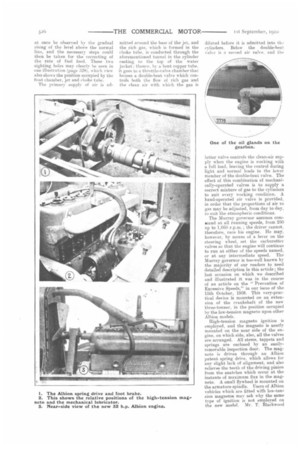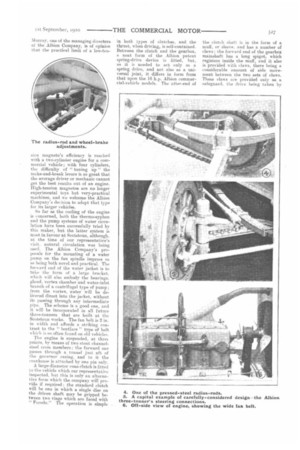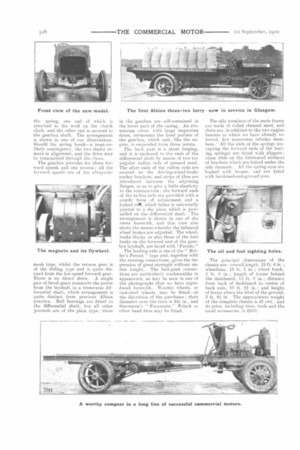The Albion Three-ton New Chassis.
Page 3

Page 4

Page 5

Page 6

If you've noticed an error in this article please click here to report it so we can fix it.
An Excellent Example of Clean and Practical Design.
The Albion Motor Car Co., Ltd.. of ..St-otstoun, has produced still another 0211111ercial-vehicle model ; this is a tlassis for gross imposed loads up to tons, of which load 15 cwt. is allowed for the body. A plan view of the new machine is reproduced at the foot of this page, and it requires but a brief examination to convince our readers that its designers have considered every detail of its construction most carefully, especially those two highly-important yet often ill-considered features, simplicity and accessibility of parts. This new and welltried machine—a representative of this journal saw the first Albion experimental three-tonner over a year ago, while on one of his periodical visits to the works at Scotstoun—impresses is as being one of the best we have examined. Its design is continuous throughout, and there is a complete a bsenve of those " added " details, indicative of forgotten experiences with earlier machines, which frequently mark down as a second-rate chassis an otherwise-capital model. The Albion Co.'s long devotion to the manufacture of commercial motors has saved it from ninny pitfalls, during the design and development of its latest production, and, although there arc a few details in the new model that may not be found in earlier Albion commercial vehicles, such details have justified their adoption by their fanitless behaviour during the experimental and road-testing stages.
The four cylinders of the engine are cast in one piece and have ample water spaces ; the same casting also embodies a tunnel along which the rich gas from the let chamber is conducted to the throttle valve and mixing chamber of an Albion patent carburetter. Each cylinder is in. in diameter, and, with a piston-stroke of 5 in., the engine develops 32.4 h.p. according to the rating. Half-compression cams are provided, to facilitate starting. The crankshaft has five bearings, all of which are self-contained in the upper part of the cast-iron crankcase. An aluminium bottom cover is fitted, but this acts only as a sump in which the spent oil is caught; it is here prevented from again being used for the lubrication of the engine.
Each of the five journals, in turn, receives a measured quantity of oil from one of the well-known Albion patent lubricators, whilst the bigends are lubricated by the oil which is led from the journals. This oil is caught in the circumferential channels of aluminium discs that are bolted to the crank cheeks ; there is only one outlet front each of these channels, and that leads to a duct in the nearest crank pin, and to that duct the oil is directed by centrifugal force. The lubricator also delivers a definite quantity of oil to each of the cylinders and gudgeon pins, and the spent oil drains into the sump to which we have already referred. All the oil pipes are arranged inside the crankcase. The Albion Co. maintains that the spent oil should on no account again be used in the engine, although it may be employed in the gearbox and for other • purposes. Since one gallon of new oil, used as on the Albion vehicles, is sufficient for well over 500 miles of running, the cost for engine lubrication is not an expensive item. An extra supply of oil may be given to the bearings, if desired, by the simple turning of a handle which actuates the otherwise-engine-driven mechanical lubricator ; this handle rotates .continuously when the engine is running, and, consequently, it may be taken as an excellent indicator of the lubricator's working. A further indicator, or sight feed, is provided to meet the wishes of some users, and this takes the form of a glass-covered sighting hole on the off side of the crankcase. The float chamber, too, is provided with a sighting hole, so that the level of the petrol may he observed ; the normal level is at " half glass," but, if the needle valve should fail to cut off the fuel supply, the trouble could at once be observed by the gradual rising of the level above the normal line, and the necessary steps could then be taken for the correcting of the rate of fuel feed. These two sighting holes may clearly be seen in one illustration (page 328), which view also shows the position occupied by the float chamber, jet and choke tube.
The primary supply of air is ad mitted around the base of the jet, and the rich gas, which is formed in the choke tube, is conducted through the aforementioned tunnel in the cylinder casting to the top of the water jacket: thence, by a bent copper tube, it goes to a throttle-valve chamber that houses a double-beat valve which controls both the flow of rich gas and the clean air with which the gas is
diluted before it is admitted into th: cylinders. Below the double-beat valve is a second air valve, and the latter valve controls the clean-air supply when the engine is working with a full load, leaving the control during light and normal loads to the lower member of the double-beat valve. The effect of this combination of mechanically-operated valves is to supply a correct mixture of gas to the cylinders to suit every working condition. A hand-operated air valve is provided, in order that the proportions of air to gas may be adjusted, from day to day, to suit. the atmospheric conditions.
The Murray governor assumes cornmend at all running speeds, from 250 up to 1,050 r.p./n. ; the driver cannot, therefore, race his engine. He may, however, by means of a lever on the steering wheel, set the carburetter valves so that the engine will continue to run at either of the speeds named, or at any intermediate speed. The Murray governor is too-well known by the majority of our readers to need detailed description in this article; the last occasion on which we described and illustrated it was in the course of an article on the " Prevention of Excessive Speeds," in our issue of the 15th October, 1908. This very-practical device is mounted on an extension of the crankshaft of the new three-tonner, in the position occupied by the low-tension magneto upon other Albion models.
High-tension magneto ignition is employed, and the magneto is neatly mounted on the near side of the engine, on which side, also, all the valves are arranged. All stems, tappets and springs are enclosed by an easilyremovable inspection door. The magneto is driven through an Albion patent spring drive, which allows for any slight lack of alignment, and also relieves the teeth of the driving pinion from the snatches which occur at the instants of maximum flux in the magneto. A small flywheel is mounted on the armature spindle. Users of Albion vehicles which are fitted with low-tenz sion magnetos may ask why the same type of ignition is not employed on the new model. Mr. T. Blackwood Murray. one of the managing directors of the Albion Company, is of opinion that the practical limit of a low-ten sion magneto's efficiency is reached with a two-cylinder engine for a commercial vehicle; with four cylinders, the difficulty of "tuning up" the make-and-break levers is so great that the average driver or mechanic cannot get the best results out of an engine. High-tension magnetos are no longer experimental toys but very-practical machines, and we welcome the Albion Company's decision to adopt that type for its larger vehicles.
So far as the cooling of the engine is concerned, both the thermo-syphon and the pump systems of water circulation have been successfully tried by this maker, but the latter system is most in favour at Scotstoun, although, at the time of our representative's Visit, natural circulation was being used. The Albion Company's proposals for the mounting of a water pump on the fan spindle impress us as being both novel and practical. The forward end of the water jacket is to take the form of a large bracket. which will also embody the bearings, gland, vortex chamber and water-inlet branch of a centrifugal type of pump; from the vortex, water will be delivered direct into the jacket, without its passing through any intermediate pipe. The scheme is a good one, and it will be incorporated in all future three-tonners that are built at the Scotstoun works. The fan belt is 2 in. in width and affords a striking contrast to the " bootlace " type of belt which is so often found on old vehicles.
The engine is suspended, at three points, by means of two stout channelsteel cross members the forward one passes through a tunnel just aft of the governor casing, and to it the crankcase is attached by one pin only. A large-diameter cone clutch is fitted to the vehicle which our representative inspected, but this is only an alternative form which the company will provide if required ; the standard clutch will be one in which a single disc on the driven shaft may be gripped between two rings which are faced with " Ferodo." The operation is simple in both types of clutches, and the thrust, when driving, is self-contained. Between the clutch and the gearbox, a neat form of the Albion patent spring-drive device is fitted, but, as it is needed to act only as a spring drive, and not also as a universal joint, it differs in form from that upon the 16 h.p. Albion commercial-vehicle models. The after-end of
the clutch shaft is in the form of a muff, or sleeve. and has a number of claws ; the forward end of the gearbox mainshaft has a long spigot, which registers inside the muff, and it also is provided with claws, there being a considerable amount of side movement between the two sets of claws. These claws are provided only as a safeguard, the drive being taken by
the spring, one end of which is attached to the muff on the clutch shaft, and the other end is secured to the gearbox shaft. The arrangement is shown in one of our illustrations. Shimld the spring break—a most-unlikely contingency, the two shafts remain in alignment, and the drive may he transmitted through the claws.
The gearbox provides for three forward speeds and one reverse ; all the forward speeds are of the always-in
mesh type, whilst the reverse gear is of the sliding type and is quite distinct from the low-speed forward gear. There is no direct drive. A single pair of bevel gears transmits the power from the layshaft to a transverse differential shaft, which arrangement is quite distinct from previous Albion practice. Ball bearings are fitted to the differential shaft, but all other journals are of the plain type; those
in the gearbox are self-contained in the lower part of the casing. An aluminium cover, with large inspection doors, surmounts the fixed portion of the gearbox, which unit, like the engine, is suspended from three points.
The back axle is a stout forging, and it is anchored to the ends of the differential shaft by means of two triangular radius rods of pressed steel. The after ends of the radius rods are secured to the driving-wheel-brake anchor brackets, and strips of fibre are introduced between the adjoining flanges, RO as to give a little elasticity to the construction ; the forward ends of the radius rods are provided with a sturdy form of adjustment and a forked enII, which latter is universally jointed to a die piece which is join-nailed on the differential shaft. The arrangement is shown in one of the views herewith, and this view also shows the means whereby the balanced wheel brakes are adjusted. The wheelbrake blocks, as also those of the foot brake on the forward end of the gearbox layshaft, are faced with "Ferodo."
The leading axle is one of the " Butler's Patent "type and, together with the steering connections, gives the impression of great strength without undue weight. The ball-joint connections are particularly workmanlike in appearance, as may he seen in one of the photographs that we have reproduced herewith. Wooden wheels, or cast-steel wheels, may be fitted—at the discretion of the purchaser ; their diameter over the tires is 34.k. in., and Stevenson's " Faransure." Polack or other band tires may be fitted, The side members of the main frame. are made of rolled channel steel, and there are, in addition to the two engine. bearers to which we have already referred, five transverse tuhular members. All the ends of the springs (excepting the forward ends of the leading springs) are fitted with slippers;_ these slide on the lubricated surfaces of brackets which are bolted under the side channels. All the spring eyes are bushed with bronze, and are fitted with hardened-and-ground pins.
The principal dimensions of the chassis are : overall length, 19 ft. 6 in. ; wheelbase, 13 ft.. 1 in. ; wheel track, 5 ft. 6 in.; length of frame behind the dashboard, 15 ft. 6 in.; distance from back of dashboard to centre of bark axle, 10 ft. 6* in. ; and height of frame above the level of the ground, 2 ft. 8* in. The approximate weight of the complete chassis is 42 cwt., and its price, including tires, tools and the usual accessories, is £610.






















